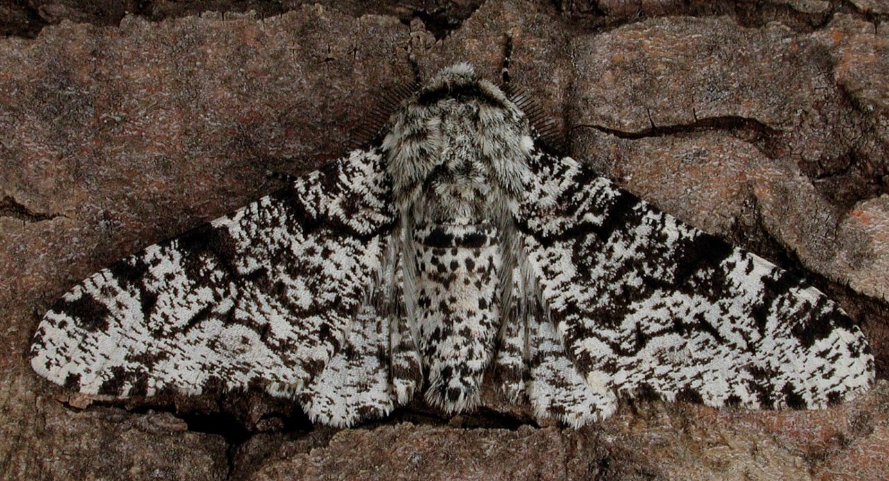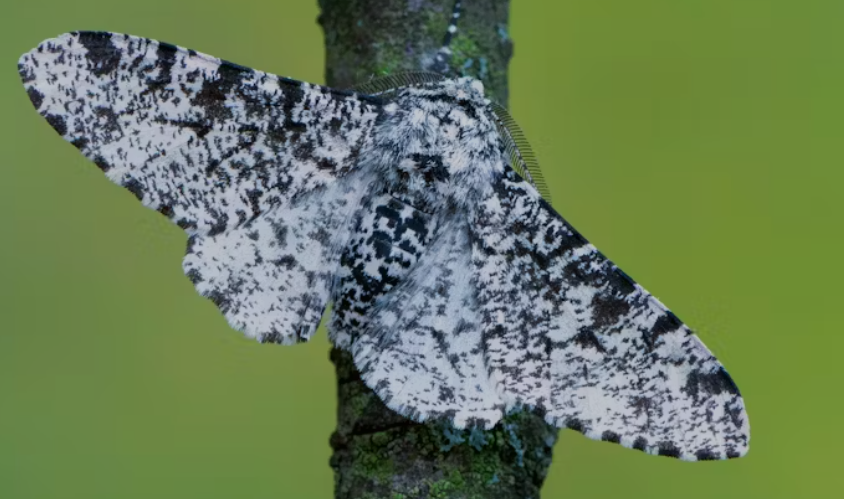
Classification
The Peppered Moth (Biston betularia) is a member of the family Geometridae, commonly known as geometer moths, which are named for the “measuring” motion of their caterpillars. It belongs to the genus Biston within the order Lepidoptera, which includes all moths and butterflies. This species is notable in evolutionary biology studies for its color variation and adaptive camouflage, which have made it a textbook example of natural selection.
Identifying Characteristics
Adult Peppered Moths are medium-sized, with a wingspan ranging from 1.6 to 2.2 inches (40–55 mm). They exhibit two main color morphs: the typica form, which is pale with black speckling, and the carbonaria form, which is almost completely black. These color variations allow them to blend into different environments, such as lichen-covered trees or soot-darkened bark. The forewings are generally patterned with fine speckles, while the hindwings are lighter and plain. Their bodies are stout and covered in fine scales, aiding in their camouflage.
Distribution
The Peppered Moth is native to Europe, North America, and parts of Asia. It is widespread in temperate regions, where its population density varies according to environmental conditions and the presence of suitable habitats. The species is non-migratory and tends to remain localized, although small dispersal occurs as adults search for mating or egg-laying sites.
Migration & Habitat
Peppered Moths are generally stationary rather than migratory, preferring habitats such as woodlands, parks, and suburban areas. They are most commonly found resting on tree trunks, especially those covered with lichen, which provides camouflage for the lighter-colored morph. The carbonaria (dark) form became more common in industrial areas during the Industrial Revolution, as soot-covered trees offered better concealment. Today, both morphs can be found in habitats with clean air and varying bark colors.
Predators & Threats
The main predators of Peppered Moths are birds, which hunt primarily by sight. Their camouflage is critical for survival, as poorly camouflaged individuals are more likely to be eaten. Other threats include habitat loss, pollution, and pesticide use, although populations have generally stabilized with improved air quality and conservation of woodland habitats. The species’ remarkable ability to adapt its coloration to environmental changes demonstrates natural selection in action.
Lifespan of Adults
Adult Peppered Moths have a relatively short lifespan of about 2–3 weeks. During this time, their primary activities are mating and laying eggs. They are nocturnal, resting on tree trunks during the day to avoid predation and becoming active at night to feed and reproduce.
Host Plants & Diet
The larvae (caterpillars) of Peppered Moths feed on the leaves of a wide range of deciduous trees and shrubs, including birch (Betula spp.), willow (Salix spp.), oak (Quercus spp.), and hawthorn (Crataegus spp.). Adult moths, like most geometrids, do not feed, relying entirely on energy reserves stored from the larval stage. The caterpillars’ feeding habits are important for woodland ecosystems, as they help regulate foliage growth and contribute to nutrient cycling.
Life cycle of the Peppered Moth (Biston betularia)

Egg Stage
The life cycle begins when the female Peppered Moth lays small, pale eggs on the leaves or twigs of host plants such as birch, oak, willow, and hawthorn. The eggs are usually laid singly or in small clusters to reduce competition among larvae and avoid attracting predators. Depending on temperature and environmental conditions, the eggs hatch in 1–2 weeks.
Larval (Caterpillar) Stage
Upon hatching, the caterpillars emerge as small, greenish larvae. They are well-camouflaged, often resembling twigs or stems, which helps them evade birds and other predators. Peppered Moth caterpillars feed on the leaves of deciduous trees and shrubs, growing through several instars (molts) as they develop. During this stage, they accumulate the energy and nutrients required for metamorphosis.
Pupal Stage
Once fully grown, the caterpillar forms a pupa, typically among leaf litter or hidden in crevices on the tree. Within the pupal case, the caterpillar undergoes complete metamorphosis, transforming into an adult moth. The pupal stage can last 2–3 weeks under favorable conditions, but in cooler climates or during winter, it may enter diapause, delaying emergence until the following spring.
Adult Stage
The adult Peppered Moth emerges from the pupa with fully developed wings. Adults are nocturnal and spend most of the day resting on tree trunks or branches, relying on their coloration for camouflage. Their lifespan is short, typically 2–3 weeks, during which they mate and lay eggs to start the next generation. Adults do not feed, surviving on reserves accumulated during the larval stage.